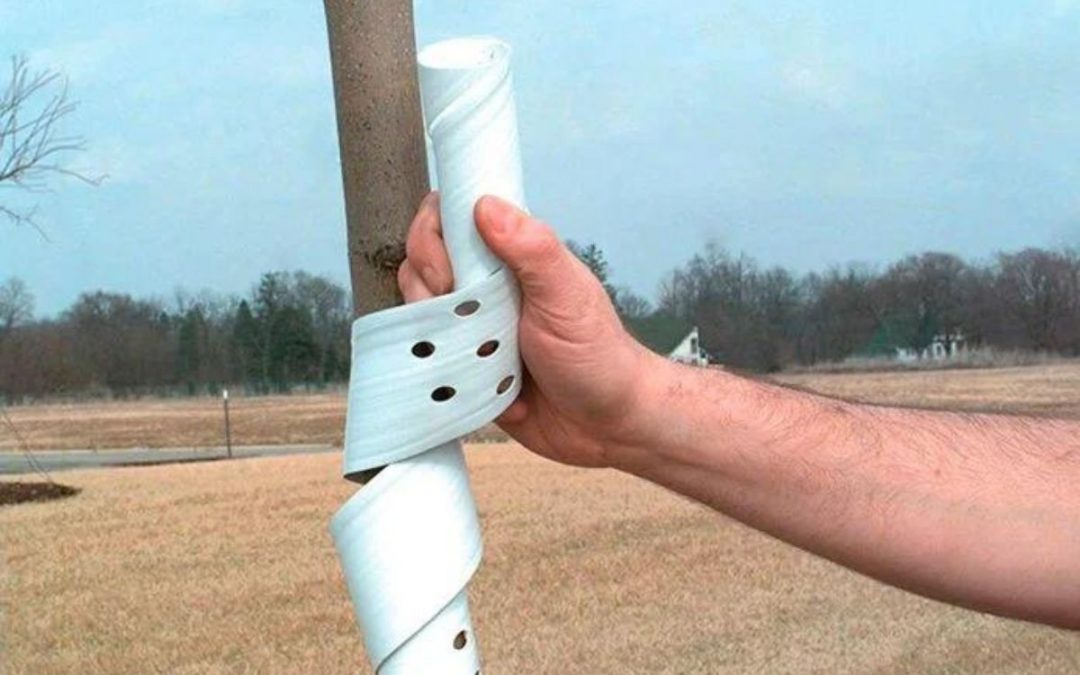Young Tree Winter Stem Protection
One of the most important things we can do to help with establishment after planting is to protect the trunks of young trees from damage. It is critical in preparing a tree for a long and prosperous life in the landscape. The question is, how do you protect your tree during the winter?
Winter exposes trees to a variety of hazards, some of which may not be immediately apparent. More than just cold air, we must be prepared for the damage that can be caused by the bright winter sun and small animal foraging. There are some important steps that can be taken to protect the trunks of young deciduous trees from these dangers and ensure a strong, sound trunk for decades to come. There are numerous types of wraps and cages available; selecting the right technique is critical to effectiveness.
How to Keep Your Tree Safe During the Winter
Winter Hazard Protection for Young Trees
As winter draws to a close, two things begin to happen: the sun becomes stronger, and food becomes scarce for many of our four-legged friends. Though these issues are unrelated, the damage caused by them can result in the same problem: areas of damaged or dead tissue on the trunk, which can lead to stunted growth, defective trunks, and even tree death. We have much less we can do for the tree once this damage has occurred, so we should focus on preventing the damage in the first place. Understanding how this damage occurs is critical for determining how to best prevent it.
How to Prevent Sunlight Damage to Your Tree
When warm, bright sunlight strikes a tree’s trunk and branches, it can heat up the bark to the point where it begins to break dormancy. This is a normal part of the process of trees waking up after a long, cold winter. However, if the air temperature remains below freezing, the bark will refreeze without hardening. This can cause the bark and cambium layer to be damaged or killed, resulting in a sunken wound on the trunk. The tree may be able to grow over and seal the wound over time, but these wounds are frequently never completely closed.
To avoid this damage, we must ensure that the tissue never warms up in the first place. To accomplish this, we must keep light away from the bark. We can accomplish this by wrapping or covering the main trunk with a light-blocking material. This wrap should ideally be white or a light color to reflect as much light as possible while heating up as little as possible.
Wraps are available in a variety of materials; we recommend white polypropylene for wrapping trunks to prevent sunscald. Trees, regardless of material, should only be wrapped for the winter to avoid girdling the trunk or rot. We recommend wrapping after the leaves fall in the fall and removing at bud break in the spring, from Thanksgiving to St. Patrick’s Day.
How to Keep Animals Away From Your Tree
The unwanted attention of animals is another major culprit for which we must be prepared. Rabbits will begin feeding on the thin bark of young trees once all of the easy, more nutritious food has been consumed. They can strip off all the bark they can reach, causing extensive girdling and even tree death. Deer antler rubbing on trees can also cause significant damage. Trees with trunk damage will often leaf out for several years after the damage, but if the wound is too large and the connection between the leaves and roots is not re-established, the roots will eventually die of starvation.
We need a strong physical barrier to protect the bark from animals. Wrapping the trunk with tree wrap or wire mesh is one option. If we’re guarding against feeding, the mesh holes should be small: 12″ or less. Wrapping for deer protection should only be done with wire mesh, but the holes should be much larger. If caging is required further away, well-supported chicken wire with larger holes can be used.
When determining how high to wrap or how tall to build cages, keep in mind that significant snow accumulation can quickly render these measures ineffective. Wire mesh can be left on trunks all year to protect them from animals, but it should be checked for girdling and adjusted if necessary.
Young trees can face a variety of challenges during their first years in the landscape; however, there are some simple steps we can take to help avoid these issues. Our ISA Certified Arborists and Board Certified Master Arborists would be delighted to advise you on the best methods to protect your landscape investment and educate you on how to protect your tree in winter.

